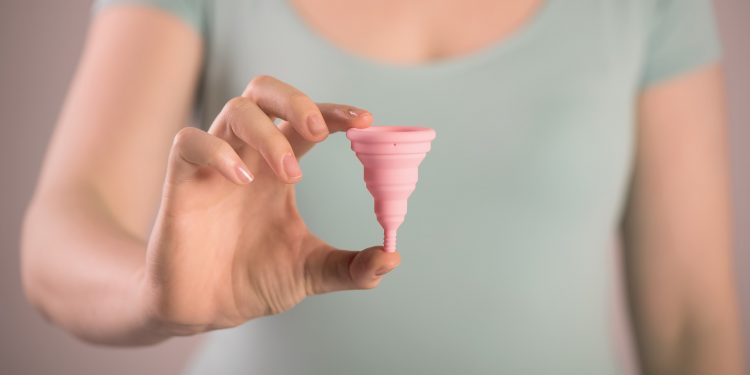Cup is the Way

“Periods”, “Aunt Flo”, and “cry of the womb”: these are some terms that are normally used for the biological process of menstruation that happens to females. Every once in a while, we come across advertisements of sanitary pads. We hear about tampons. We hear about both these sanitary protection tools having insane absorption power. Then, we hear about a cup: menstrual cup.
A menstrual cup is a soft silicone cup which has attracted a lot of attention lately. The menstrual cup is the best sanitary protection option that is available and it is important for women to be aware of its existence because it is a worthy investment in the long run, environment friendly, safer to use, and eliminates the risk of TSS.
What is a Menstrual Cup?
A menstrual cup is a funnel shaped cup made of medical grade silicone, which makes it smooth to the touch and foldable.
Menstrual cups, like tampons, have to be inserted into the vagina. Unlike a tampon, however, a menstrual cup creates a suction around the walls of the vagina and stays inside until it’s taken out. Instead of absorbing, it collects the blood that is discharged from the uterus.
Menstrual cups can be worn for as long as 12 hours at a stretch. This means that a woman who spends long hours working will not have to worry about her pad or tampon absorbing more blood that it can.
Menstrual cups were made way back in 1930s, but they have now started to gain popularity in India. However, these cups have not received the attention they deserve due to heavy advertising of pads, which are used in most parts of India.
Menstrual Hygiene and Toxic Shock Syndrome
Whenever a woman wears a pad or a tampon, she has to change it after every six hours because it soaks up a lot of blood. The dampness and warmth of pads and tampons make the perfect environment for bacteria to breed. This could lead to infections. Tampons, if worn for longer hours and in days of light bleeding can lead to Toxic Shock Syndrome (TSS), which happens when the vaginal walls are dried out excessively.
TSS can be fatal, and this is why maintaining menstrual hygiene becomes important. When a woman is menstruating, there are other fluids that her body is discharging apart from blood. During this time, a woman’s body is more prone to infections and needs to be taken the utmost care of.
Since menstrual cups are made of silicone, they don’t let bacteria get near them and breed. This eliminates the risk of TSS altogether, protecting women from one of the biggest menstrual health issues.
Busting the Myths
Menstrual cups are not often used in India despite being invented back in the 1930s. And it is not the case of India alone, as many other countries exist where culturally, people fear about a woman’s virginity when she inserts something into her vagina. Many people think that a hymen covers the vagina, like a wall, and is something that is broken at the time of sexual intercourse. In fact, hymen surrounds the vagina like an elastic rubber band and stretches (not breaks) when the vaginal opening is widened.
Women are afraid to use menstrual cups also because they think that the cup will “get lost” once they insert it. This is another myth. Vaginal walls are soft and lubricated. A menstrual cup has tiny holes near its mouth that allows the cup to create a suction once it is inside the vagina, making it stay at one place.
Another myth is that, like pads and tampons, a cup restricts women from doing extensive activities. It is here that the cup is the most useful. Since menstrual cups don’t move once they are inserted into the vagina, women can do activities from swimming to horse riding without any worries.
Menstrual Cups versus Other Sanitary Protection Options
In India, sanitary pads cost as low as ₹10 and go up to more than ₹100, so that women from all economic backgrounds are able to use pads at the time of menstruation. Tampons, on the other hand, are slightly more expensive, and only a section of the society uses tampons.
Adolescent girls in schools, especially in poverty stricken areas, might not get the adequate requirements like water or privacy when they are menstruating, and that is why many adolescents tend to miss classes during menstruation, especially in rural areas. Moreover, sanitary pads and tampons need to be changed frequently, which leads to higher expenditure.
Menstrual cups require a one-time investment. In India, menstrual cups cost as low as ₹600 to as high as over ₹3,000. While this cost seems expensive to some, one thing that needs to be kept in mind is that these cups don’t need to be changed very often and can be used for as long as 12 hours, and they are reusable for up to 10 years. These cups just need to be properly washed and reused, making it easier for poor women to use something that will not be expensive in the long run, be safe to use, and not require frequent visits to the washroom.
Environment and Menstrual Cup
Women all around the world use sanitary pads and tampons which they dispose about thrice a day for 5 days every month for several years. Every day, the pile of disposed sanitary pads and tampons keeps growing. Pads and tampons are non-biodegradable, which means that they will take a long time to vanish from earth. This means that every day the environment is getting more and more polluted by non-biodegradable items.
Menstrual cups, because of their longevity, pose much lesser threat to the environment. There is no odour or risk of infection because the cup doesn’t absorb blood and prevents bacteria from breeding. Moreover, a menstrual cup is washed and reused, unlike pads and tampons which are dumped into the trash which, if kept for longer hours, can spread infection.
Future of Menstrual Cups
Companies manufacturing sanitary pads make sure that they advertise the product as rigorously as possible. Tampons and menstrual cups are not advertised, but the former is still known to many because of sanitary pads. Menstrual cups, on the other hand, have attracted less attention. However, in the past few years, many social media platforms have started to advertise menstrual cups and talk about its benefits.
Sonal Jain and Bharti Kannan, co-founders of Boondh, strive to spread awareness of the benefits of menstrual cups in rural areas of Rajasthan, Uttarakhand, Jharkhand and Thrissoor, where women have started to use menstrual cups. Their story has been published in a few newspapers and websites through which Boondh has gained some recognition.
Social media has become a platform for women to discuss about menstrual health. Women are no longer shy to talk about menstruation. Most women talk about menstruation amongst their peers, and this is the best way to talk about menstrual cups. WhatsApp forwards and Facebook posts spread faster and wider among people, and this is one way through which the word about menstrual cups can be communicated.
Workshops about menstrual hygiene, the hymen, and menstrual cups must be conducted in schools and colleges to eliminate from the minds of young women that menstruation isn’t something to talk about and eradicate the misconceptions regarding the hymen. Through these workshops, more and more women will come to know about menstrual cups faster and understand the benefits of using these cups. In fact, these workshops can be organised in the form of short skits, and can be organised in schools, colleges, places that attract larger audiences like shopping malls. These workshops would be even more helpful in remote areas and villages where women have no knowledge about menstrual cup and its benefits.
Women nowadays are more aware of their menstrual health and are confident to talk about it. This needs to continue so that eventually, not a single woman is too afraid or shy to talk about menstruation. Menstrual cups are not just better sanitary protection options, but they also encourage women to understand their bodies better, which leads to them taking better care of themselves and of other women around them.
Image Attribute: Pixabay
